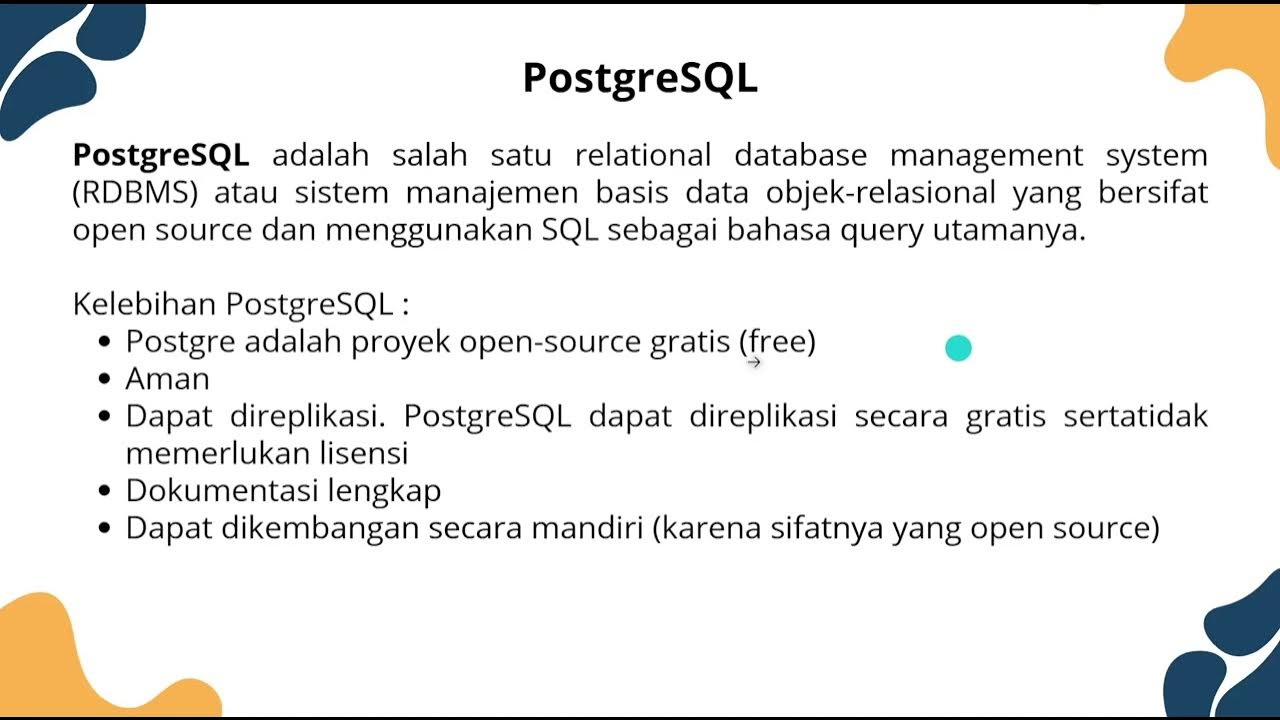Introduction To DBMS
Summary
TLDRIn this sum online lecture series, Professor Muhammad Abah Bukari introduces the fundamental concepts of database management systems (DBMS). He explains the nature of data and information, their types, and the importance of organizing data for decision-making. The professor elaborates on structured and unstructured data, qualitative and quantitative data, and the role of DBMS in securely storing, retrieving, and managing data. He also discusses various components of DBMS, including hardware, software, data procedures, and data languages, emphasizing their significance in modern information systems.
Takeaways
- 😀 Data is a collection of information gathered through observations, measurements, research, or analysis, and can be organized in various forms like graphs, charts, or tables.
- 🔍 Data types are categorized into structured and unstructured data, with structured data being neatly organized and unstructured data being more chaotic.
- 📊 Qualitative data is descriptive or subjective, while quantitative data is numerical, such as shoe sizes or student weights.
- 💡 Information is the processed data that has context, relevance, and purpose, making it meaningful and valuable for decision-making.
- 📚 The process of data becoming information involves organizing and interpreting data to make it useful for specific purposes.
- 🛠️ Database Management Systems (DBMS) are software collections that construct, expand, and maintain databases, providing an interface between users and data.
- 🗂️ A database is a collection of related files, records, and fields, which are organized to store and manage data efficiently.
- 🔑 Security in databases is crucial to prevent unauthorized access and ensure that sensitive data is protected.
- 👨🏫 The components of a DBMS include hardware, software, data, procedures, and data languages, all working together to manage data effectively.
- 📝 Data Access Languages, such as Data Definition Language (DDL), Data Manipulation Language (DML), and Data Control Language (DCL), are used to interact with databases by accessing, updating, and managing data.
Q & A
What is the main topic of the lecture series presented by Muhammad Abah Bukari?
-The main topic of the lecture series is 'Database Management System', which explores the foundational concepts that form the backbone of modern information systems.
What does the term 'data' represent in the context of the lecture?
-In the context of the lecture, 'data' represents a collection of information gathered by observations, measurements, research, or analysis. It can consist of facts, numbers, names, figures, or descriptions of things.
How is data different from information according to the lecture?
-Data is a raw collection of facts or figures, while information is data that has been organized and processed to make it meaningful and valuable for decision-making.
What are the two broad categories of data mentioned in the lecture?
-The two broad categories of data mentioned are quantitative data and qualitative data. Quantitative data includes numbers, while qualitative data is descriptive or subjective.
Can you provide an example of qualitative data from the lecture?
-An example of qualitative data given in the lecture includes names, colors, and descriptions like 'smiling' or 'frustrated'.
What is the role of a Database Management System (DBMS)?
-A DBMS is a collection of software that constructs, expands, and maintains databases. It provides an interface between users and data in the database, allowing for efficient storage, retrieval, and management of data.
What are the different types of data types discussed in the lecture?
-The lecture discusses structured data, unstructured data, and semi-structured data. Structured data is neatly organized, unstructured data is disorganized, and semi-structured data falls in between.
What is the significance of a database in the context of the lecture?
-A database, in the context of the lecture, is a collection of related files, which in turn are collections of related records, fields, and characters, used to store and manage data effectively.
What are the components of a database management system as discussed in the lecture?
-The components of a database management system include hardware, software, data, procedures, and data languages such as DDL, DML, and DCL.
Why is it important to secure data in a database?
-Securing data in a database is important to prevent unauthorized access and ensure that sensitive information is protected, maintaining the integrity and confidentiality of the data.
What is the purpose of data access language in a DBMS?
-Data access language in a DBMS is used to write commands for accessing, updating, deleting, or manipulating data in the database, allowing users to interact with and manage the stored information.
Outlines

هذا القسم متوفر فقط للمشتركين. يرجى الترقية للوصول إلى هذه الميزة.
قم بالترقية الآنMindmap

هذا القسم متوفر فقط للمشتركين. يرجى الترقية للوصول إلى هذه الميزة.
قم بالترقية الآنKeywords

هذا القسم متوفر فقط للمشتركين. يرجى الترقية للوصول إلى هذه الميزة.
قم بالترقية الآنHighlights

هذا القسم متوفر فقط للمشتركين. يرجى الترقية للوصول إلى هذه الميزة.
قم بالترقية الآنTranscripts

هذا القسم متوفر فقط للمشتركين. يرجى الترقية للوصول إلى هذه الميزة.
قم بالترقية الآنتصفح المزيد من مقاطع الفيديو ذات الصلة

Lec-2: Introduction to DBMS (Database Management System) With Real life examples | What is DBMS

KONSEP DASAR SISTEM MANAJEMEN BASIS DATA #1 [PERANCANGAN BASIS DATA]

Introduction to Databases

SBD1 Pertemuan 1 | 3IA09,3IA10,3IA11,3IA13,3IA16

Introduction of DBMS | Database Management System | Lec -01 Hindi

Introduction to DBMS | RGPV Diploma CSE / IT 4th Sem 2nd Year
5.0 / 5 (0 votes)
